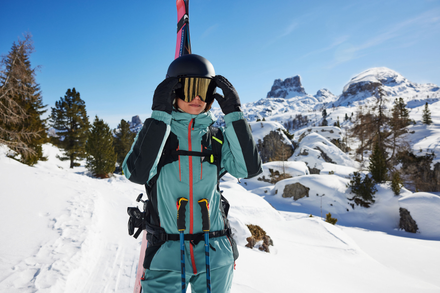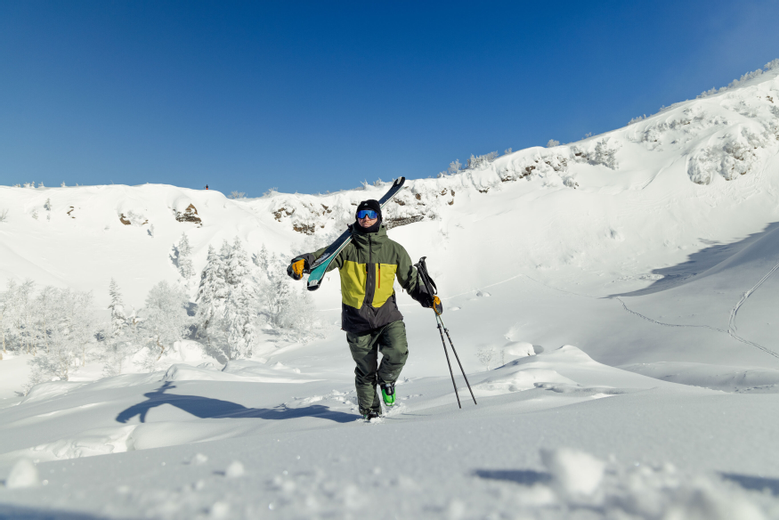
How to wash your ski wear?
When washing your ski and snowboard clothing, this is what you need to do:
- Read and follow the care instructions
- Check for stains and treat them before the washing, empty pockets
- Wash two garments at a time, on a delicate cycle, use mild detergent
- Hang dry out of direct sunlight
Just like your board and your skiis, your outerwear needs looking after. After each use, give your outerwear some TLC - hang ski jackets and trousers to dry thoroughly. Remember that starting your day in dry gear is the best way to stay warm. Some people simply never wash their gear. Now that’s an option but it won’t help the functionality of your jacket or trousers. When you’re out carving up the slopes, you perspire, you may even get dirty!
Moisture and dirt will effect just how water resistant and breathable your clothing is. These elements can damage the protective layer that covers your outerwear, allowing water to enter the fabric, leaving you wet and cold. So occasional cleaning is good but what method is best?
Here’s what to do:
Tips for washing your ski wear!
Start with reading the care label
Most of our outerwear garments have the same care instructions but you never know, so check the label – maybe your garment needs a different kind of care. Generally these are the recommended cleaning instructions for our outerwear.
- DO NOT dry-clean or bleach your garment
- Machine wash in warm water (below 30˚C)
- Use a mild detergent or technical cleaner and rinse well
- (Generally) DO NOT tumble dry, hang to dry in the shade
- Treat heavily soiled areas before wash cycle
- DO NOT iron
Here’s a breakdown of Protest washing instructions symbols and what they mean.
Do not use fabric softener (ever)
Do not bleach (no matter what)
Do not dry clean
Do not iron
Do not tumble dry
Hand wash only
Do not soak
Do not wring
Wash inside out at 30C
Wash separately
Check for stains and treat them before wash
Check and treat bad stains before the garment goes in the wash. You can do this by rubbing some mild detergent into the stain with a sponge or soft cloth before putting your outerwear in the machine.
Check pockets and close zippers before wash
Make sure that your garment isn’t taking any passengers along for the ride. Check all pockets for tissue, maps, sharp objects and other things. Then close all zippers and close all velcro parts. Loose velcro parts can catch onto other garments and cause damage.

Clean your washing machine before wash
This is not a necessary step but a precautionary one you may want to take! The inside of your washing machine may be lined with bits of detergent and softener. These remnants can damage the fabric and the water resistant coating of your ski and snowboard clothing. So before you get down to washing your clothes, it’s a good idea to rinse your machine with a hot cycle to clean all that built-up residue away.
Which detergent to use?
The detergent that you use to wash your ski wear should be mild. Look for a gentle detergent like Woolite or Dreft. You can also use a specialized detergent (like Nikwax products) made for water resistant outerwear, which will clean and protect the DWR coating of your ski and snowboard clothing.
Can you use fabric softener?
It’s a good question and the simple answer is never. Fabric softener is bad for the water resistance of you ski and snowboard outerwear. It will clog the pores in the fabric, affecting how breathable the fabric is. So don’t do it!
How to wash a ski jacket or trousers?
If your ski clothes can be machine washed, use cold or cool water and the delicate cycle with a low spin speed. Use a gentle detergent or one that is specially formulated for waterproof outerwear. Don’t fill the machine and we’d recommend only washing two garments at a time. This will result in a better wash and a cleaner garment. Remember to wash similar colours and fabrics together. And another tip – don’t use fabric softener. This will clog the pores in the fabric, affecting how breathable the fabric is.
After the washing cycle is finished, remove from washing machine immediately. You don’t want smelly ski wear and that’s what will happen if you leave your wet clothes in the machine for too long.
Optional: Add some water-resistance to ski jacket and ski trousers
Now your garment is clean. You could consider topping up the water-resistance of your garment. This can be done in two ways.
Option 1: Put the garment through a second wash cycle, this time using a waterproofing solution to increase the water-resistance. Your garments do not need to dry between washes.
Option 2: You can also add water-resistance with a waterproofing spray. Always follow the product instructions and always spray outdoors or in a well-ventilated area. Spray an extra layer on hard wear areas like the seat of your trousers and the shoulders if you wear a backpack.

How to wash your puffer jacket?
Washing a puffer jacket involves the same steps as with a regular ski and snowboard jacket. Read the care instructions, remove stains, check pockets and then wash on a delicate cycle with cold water and a mild detergent. Here at Protest we only use synthetic down, which is both super insulating as well as being duck-friendly.
Are you washing a puffer jacket which has natural feather down? Then the drying procedure is different. Puffer jackets can usually be put in the dryer at a low temperature as it is important that a puffer drys thoroughly (check your label to see if your jacket is allowed in the dryer). To make sure that the feathers don’t clump together you can try putting 3 tennis balls (or drying balls) in the dryer with your puffer. If you don’t have tennis balls handy, try rolling up some thick socks instead! These ‘balls’ will help to restore your jacket’s fluffiness.
How to wash softshell ski jackets or trousers?
Remember to follow the instructions on the care label and follow the pre-wash guidelines above. Softshell fabric can generally tolerate a wash at 40 degrees, but it’s better to stick to 30 degrees for the sake of the fabric. Like with regular ski wear, a delicate wash cycle is best and after you’re done washing your garment, we recommend putting it through a rinse cycle. A tumble dry on low heat is sometimes advised to boost the water resistant layer so check that label.
How to wash a (fleece) mid layer?
That essential layer of warmth needs looking after too. As with all of your clothing, check the care label before washing and follow the pre-wash steps above. Before washing, turn your mid layer inside out to avoid unnecessary piling. Use a mild detergent and don’t use fabric softener. Choose a gentle wash cycle at a low temperature. That low temperature is better for your garment and better for the environment. It’s best to line dry your mid layer.
Can you wash ski gloves and mittens?
Om ervoor te zorgen dat je handen warm en droog blijven terwijl je de piste af scheert, is het ook belangrijk goed voor je handschoenen en wanten te zorgen. (Even tussendoor: als we het hierna over handschoenen hebben, bedoelen we handschoenen én wanten!) Als je handschoenen waterafstotend zijn, kun je ze het beste met de hand wassen. Zo doe je dat:
De gemakkelijkste manier is ze te dragen terwijl je ze wast. Trek je handschoenen aan, breng wat milde zeep aan op je handpalmen en wrijf ze tegen elkaar. Vergeet ook de achterkant van je handen en je polsen niet. Voor hardnekkige vlekken heb je eventueel wat meer zeep nodig. Houd je handschoenen aan en spoel ze nu goed uit. Bijkomend voordeel: door ze te dragen tijdens het wassen, behouden je handschoenen hun vorm. Om de binnenkant te wassen, draai je ze binnenstebuiten en doorloop je opnieuw de bovenstaande stappen.
Probeer na het uitspoelen zoveel mogelijk water uit de handschoenen te knijpen. Maar onthoud goed dat je ski- en snowboardkleding nóóit uitwringt – daarmee beschadig je de stof. Laat je handschoenen aan de lucht drogen en let op dat je ze niet in direct zonlicht hangt. Merk je bij het dragen dat er vocht door je handschoenen naar binnen komt? Spray ze dan in met een waterafstotende spray. Lees altijd de instructies op het label voordat je dit doet. Et voilà, je handen zijn klaar voor je dagen in de sneeuw. Om een extra beschermende laag toe te voegen aan je handschoenen, kun je Nikwax Glove Proof gebruiken.
Deze instructies gelden voor onze ‘outerwear’ – jassen, broeken en handschoenen. Voor pullies en andere artikelen kun je het beste even op het label kijken. Er zijn producten verkrijgbaar die de isolerende, ademende en vochtafvoerende eigenschappen van je kleding kunnen verbeteren.
How to wash your beanie?
You may think that you can just throw your beanie into the washing machine but no, your head’s best friend needs some hands-on attention. To maintain the elasticity of your beanie, it’s better to wash it by hand. Use a mild detergent and cool water – hot water can cause shrinkage and a loss of colour. Submerge your beanie in cool, soapy water and then squeeze it and release. Do this a couple of times. Empty away the soapy water and rinse your beanie thoroughly with clean cold water. Make sure all the soap residue is gone and squeeze out all the excess water. Reform your beanie into a nice beanie shape. Then dry flat.
How to wash ski socks?
All of our ski socks are made from a blend of synthetic fibres. These fibres are moisture wicking, warm and stretchy. To clean these socks, firstly turn them inside out. Wash at a cool or warm temperature on the synthetic or permenet press cycle. Synthetic socks can handle regular detergent, no problem. Don’t use a hot wash as this will damage the fabric fibres. Air dry your socks. If you have wool socks, it’s important to use a mild detergent and a cold or cool gentle wash cycle. Air dry these socks as well.
Can you dry clean ski wear?
No, don’t do it! The chemicals that are used to dry clean garments are way too harsh for functional ski and snowboard clothing. These chemicals can damage the water resistance finish, allowing moisture to enter your ski clothes. Not good.
How to dry your ski wear?
Remember to consult your label. As a rule, do not tumble dry your gear. For most of our outerwear garments, we recommend drying them in the shade, out of direct sunlight. Hang your gear on a sturdy hanger that won’t rust. Make sure your garments are clean and completely dry before storing. Fold them nicely away and start planning for the next time you can take them out of the closet.
Tips for our enviroment
- Using cold water for the wash cycle saves energy.
- Save energy by only tumble drying when really necessary.
- Use a non-toxic waterproofing solution. They do exist.
- Only use the necessary amount of detergent to reduce what flows into the water.
- Wash your clothes only when needed.
- Instead of buying new outerwear when the water resistance of your garment starts to decline, simply restore the water resistance with wash-in or spray-on products.

Conclusion
This was our guide to washing your ski and snowboard clothing. Remember wash with care, always read the label and only wash when needed. Follow our tips to have your gear ready for action this winter.